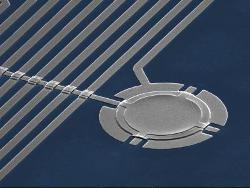A microscope to process information and control the movement of a large object at the quantum level has been developed by scientists working on a research project at the National Institute of Standards and Technology. It involves microwaves within an electromechanical circuit that can interact with a mechanical part that vibrates.
 NIST's Aluminium Drum
NIST's Aluminium Drum
The experiments have been detailed in the March 10 issue of Nature. Microwave light that oscillated 7.5 billion times/second communicated with a micro drum that vibrated at radio frequencies of 11 million times/second. The experiments involved joining microscopic apparatus with electromagnetic radiation. The rate of energy in the coupling is stronger while the vibrations last longer.
The tool looks like a bodhrán, which is an Irish drum. It is a circular aluminum membrane that measures 100nmx15 micrometer. It is light and vibrates freely. The experiments altered the energy emitted by the microwave by 56MHz/nanometer of motion. The drum, which is integrated in a superconducting hole, is cooled to 40milliKelvin. It is at this temperature that aluminum lets an electric current flow freely, revealing its quantum characteristic. The researchers then applied microwaves to the hole. A drive tone was adjusted to the difference between the radiation photons of the microwave frequencies and the drum, enhancing the coupling strength. This allowed the two devices to interact at a rate faster than that at which their energy disperses. The microwaves can measure and manage the vibrations of the drum. The drum will vibrate for hundreds of microseconds.
The drum, which functions as a capacitor has the ability to hold charge. When it vibrates, the capacitance alters, while the mechanical movement monitors the characteristics of the electrical circuit. The drum will help the researchers design systems to be used to conduct quantum computers and simulations.
Source: http://www.nist.gov/